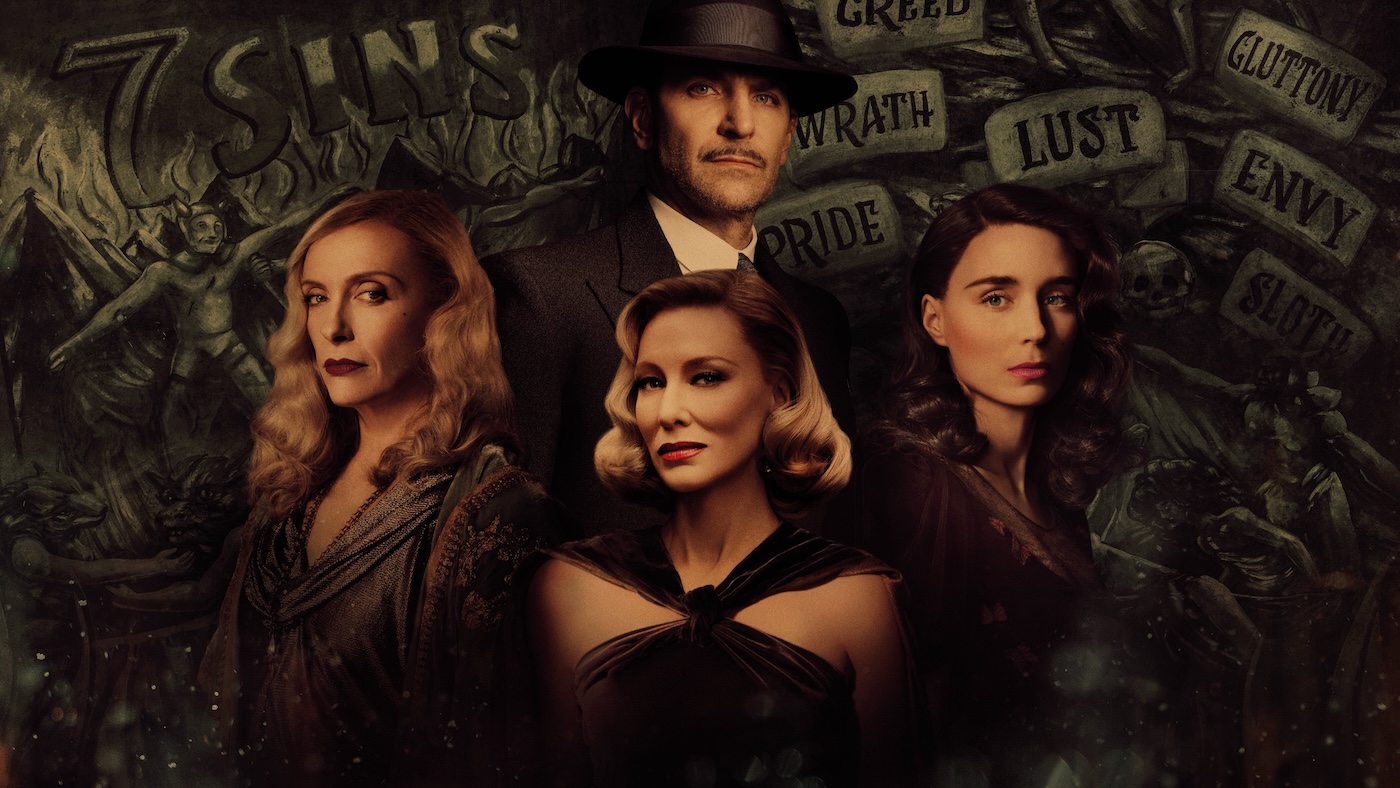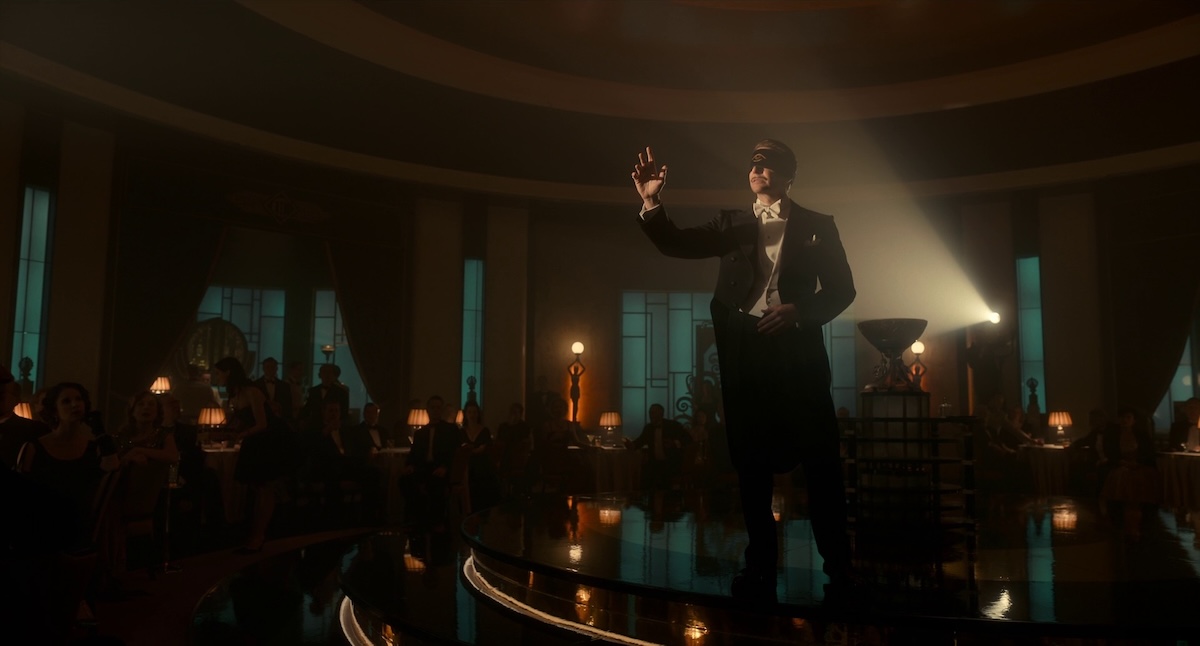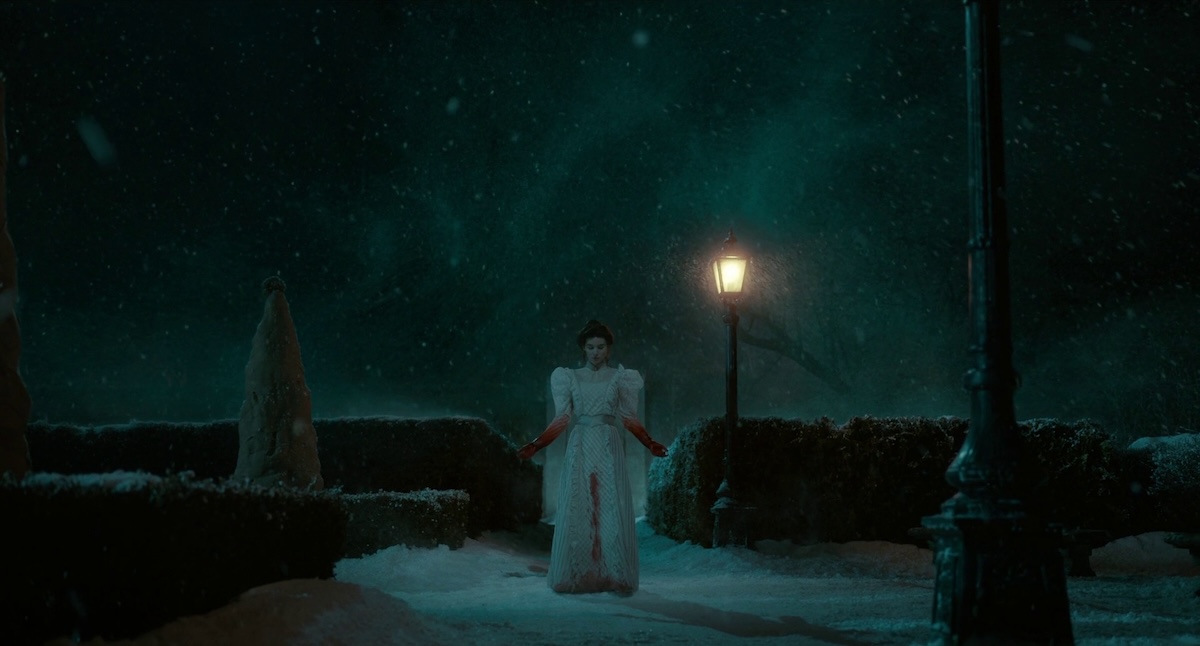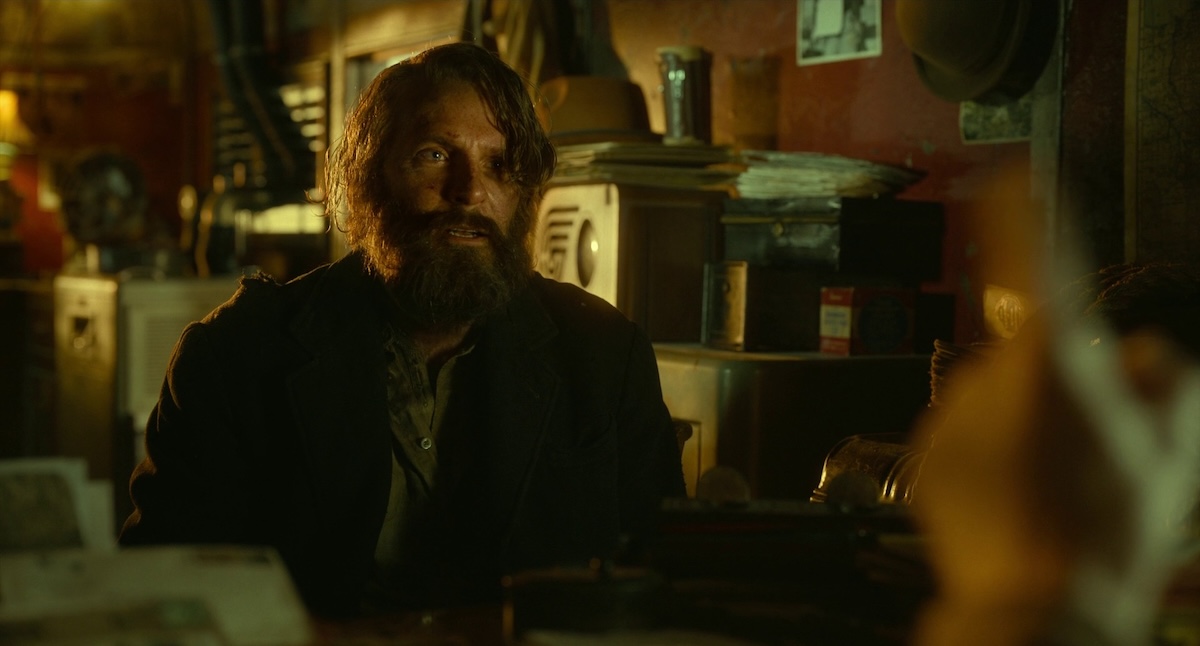NIGHTMARE ALLEY (2021)
A grifter working his way up from low-ranking carnival worker to lauded psychic medium matches wits with a psychologist bent on exposing him.

A grifter working his way up from low-ranking carnival worker to lauded psychic medium matches wits with a psychologist bent on exposing him.

Edmund Goulding’s Nightmare Alley (1947) endures as one of the most audacious and psychologically corrosive achievements to emerge from Hollywood’s Golden Era. It remains a remarkably faithful interpretation of William Lindsay Gresham’s novel, preserving enough of his morbid fascination with the darker recesses of human ambition that challenged the strictures of the Hollywood Production Code. Informed by the author’s firsthand experience among carnivals and sideshows, Goulding transforms the material into a bleak inversion of the Horatio Alger myth.
It’s the quintessential American Dream fable told in reverse, where self-invention leads to spiritual ruin. Reportedly, Tyrone Power was instrumental in bringing the project to fruition as a desperate attempt to distance himself from the debonair rôles that the studio system had tasked him with. The actor personally convinced 20th Century Fox studio executive Darryl F. Zanuck to acquire the rights to Gresham’s novel, envisioning Nightmare Alley as a vehicle to prove his dramatic depth.
Guillermo del Toro first became acquainted with Gresham’s story long before his name became synonymous with dark fantasy and gothic imagination. While shooting his directorial début Cronos (1993), the Mexican filmmaker developed a close friendship with Ron Perlman (Pinocchio), spurred by their shared fascination with the macabre. During their conversations, the actor spoke about his admiration for Goulding’s Nightmare Alley. Although del Toro had never seen the adaptation, its preoccupations with trickery and illusion immediately resonated with his own artistic sensibilities. Inspired, he began adapting the source material, aligning Gresham’s tale with his enduring interest in the grotesque beauty of human frailty. However, legal complications surrounding the property halted the project before it could even materialise.

Nearly three decades would pass before del Toro returned to Gresham’s nightmarish carnival world. When he finally revisited Nightmare Alley, he was in a vastly different place in his career. He was no longer a young filmmaker struggling to articulate his voice, but an auteur at the height of his creativity. Del Toro was fresh off his Academy Award triumph for The Shape of Water (2017) with enough creative authority necessary to realise his long-gestating vision. Collaborating with Kim Morgan (The Forbidden Room), del Toro imbues Goulding’s noir with his fascination for the moral and metaphysical shadows that dwell within humanity. Rendered through his idiosyncratic lens of tragic romanticism and mythic horror, del Toro’s reinvention of Nightmare Alley emerges as a haunting moral parable about the darkness that accompanies the pursuit of transcendence.
Taking place during the aftermath of the Great Depression and on the cusp of World War II, Stanton Carlisle (Bradley Cooper) is a man of unpolished charm and festering secrets. While evading a tortured past he refuses to confront, he finds refuge in a travelling carnival populated by tricksters, mystics, and broke souls. After integrating himself and becoming a part of the community, Stanton befriends the clairvoyant Zeena (Toni Collette) and her inebriated husband Pete (David Strathairn). The pair possesses a clandestine manual that codifies the art of psychological manipulation as spiritual revelation. While under their guidance, Stanton masters the linguistic sleight of hand that allows the illusion of supernatural insight. After refining his charisma and envisioning a grander stage for his ambitions, he abandons the carnival’s transient world of sawdust and spectacle. Accompanied by his innocent sideshow assistant, Molly (Rooney Mara), Stanton travels to New York City, where his gift for illusion promises wealth and adoration.
Several years later, Stanton meticulously reinvents himself as the sophisticated mentalist ‘The Great Stanton’. Armed with a natural command of human psychology and theatrical precision, his polished artifice enthrals the wealthy elite. Amongst his admirers is Dr Lilith Ritter (Cate Blanchett), a poised and serpentine psychoanalyst whose intelligence matches his ambition. Lilith recognises Stanton’s manipulative act and entices him into a perilous collaboration. If she provides the intimate secrets gleaned from her patients, he transforms that knowledge into a lucrative performance of false revelation. As their shared cynicism blossoms into a sinister partnership, the pair devise a scheme to exploit the tormented wealthy industrialist Ezra Grindle (Richard Jenkins). However, as the line between deception and belief becomes increasingly blurred, Stanton descends into moral and psychological ruin.

Fresh from his directorial triumph A Star Is Born (2018), Bradley Cooper delivers a performance of remarkable control and slow corrosion. As Stanton Carlisle, he embodies a man defined by quiet desperation whose hunger for validation festers beneath an impassive exterior. Cooper initially cloaks Stanton in a quiet opacity, a spectral presence who watches more than speaks as he drifts between tents and smoke. His haunted stillness communicates volumes, with each elongated pause and hollow gaze carrying the weight of unspoken shame and ambition. Yet, as the character learns to weaponise deceit and psychological manipulation, the actor cultivates the confidence of a charismatic showman. His posture straightens, his movements sharpen, and his voice smooths into a seductive rhythm. It’s a delicate balancing act and Cooper resists the temptation to overplay Stanton’s descent. Instead, he renders his turn as a gradual peeling away of humanity, each layer revealing the emptiness beneath the confident veneer.
Matching Cooper’s hunger for control with her own brand of psychological gamesmanship, Cate Blanchett (Tár) delivers a masterclass in controlled seduction and cerebral manipulation as Dr Lilith Ritter. While conjuring the aura of Hollywood’s great noir femmes such as Gene Tierney (Laura) and Veronica Lake (This Gun For Hire), with a streak of Barbara Stanwyck’s (Double Indemnity) hardened independence, the actress imbues the archetype with a chilling contemporary intelligence. She constructs a character of wounded intellect rather than vengeance, one that’s intimately aware of the corruptibility of men. There’s a hypnotic quality to her presence the moment she appears, almost architectural in its poise. From the deliberate crossing of her legs to the seductive exhalation of cigarette smoke, every gesture of Blanchett’s performance is steeped in alluring precision. Her femme fatale is pretty poison in an ornate bottle.
Reflecting Stanton’s moral and psychological unravelling, Nightmare Alley is carefully structured as a diptych of two distinct yet thematically entwined halves mirroring his doomed ascent and fall. The first half unfolds in the 1930s, following Stanton’s entrance into the murky and claustrophobic world of the travelling carnival. Within this milieu, del Toro reaffirms his reputation as a consummate storyteller, conjuring a realm steeped in his profound fascination with damaged souls and grotesque beauty. Production designer Tamara Deverell’s (Priscilla) realises this vision with exquisite precision, crafting a hauntingly beautiful pastiche of tattered circus tents, glowing Ferris wheels, and sideshow curiosities. Wonder can be found within some decorations such as the electric chair Stanton fashions for Molly. Whereas Clem’s (Willem Dafoe) gruesome specimens preserved in jars of formaldehyde provide a chilling reminder of the cruelty underpinning the spectacle. Every frame looks simultaneously breathtaking and ominous, brought to life with the filmmaker’s traditional macabre enthusiasm.

As Nightmare Alley shifts from the rural struggle of carnival life to the polished sterility of city skyscrapers, the visual language also undergoes a profound transformation. Having absorbed the specifics of Zeena’s secrets, Stanton and Molly reinvent themselves as glamorous spiritualists who prey upon the devastating traumas of the wealthy for profit. Much like Goulding’s interpretation, it’s during this transition that del Toro pivots from a grubby picaresque to an immaculate homage to noir cinema. In his fourth collaboration with the filmmaker, Dan Lausten’s (The Shape of Water) moody cinematography is central to this metamorphosis. His camera renders the characters both seductive and inscrutable, bathing them in pools of chiaroscuro and behind ribbons of cigarette smoke. Each composition is meticulously crafted, growing more symmetrical and suffocatingly precise as Stanton’s success mounts. The interiors are composed with geometric precision, visually trapping him in the very spaces he once coveted. Whereas the fractured reflections in windows and glass partitions evoke the psychological labyrinths that Stanton cannot escape.
Though such profound ideas are realised with great delicacy, Nightmare Alley is not immune to the burden of its own ambition. Del Toro and Kim Morgan’s screenplay approaches its source material with admirable deliberation, unfolding with the tempo of inevitability rather than urgency. However, the expansive 150-minute run time buckles under the weight of its digressions. What initially feels like a rich character tapestry gradually exposes the narrative’s weaker seams, as an inordinate amount of time is spent shifting between a host of eccentric personalities orbiting Stanton’s rise.
Del Toro’s insistence on exploring every figure exhaustively while establishing the inner workings of the carnival life and offering glimpses of nightmarish flashbacks often destabilises the momentum. Still, very few filmmakers achieve presenting a world so persuasively authentic. By the time Nightmare Alley moves toward its devastating dénouement, del Toro recaptures audiences with his hypnotic grip. For those not entirely seduced by the tactile production designand vibrant cast of freaks and swindlers, the haunting brutality and tragic inevitability of the closing moments will linger long after the credits roll.

Viewers acquainted with Gresham’s novel and Goulding’s adaptation will recognise that del Toro’s Nightmare Alley diverges from its predecessors to carve a vision that’s distinctly its own. It’s almost impossible to discuss these deviations without venturing into spoiler territory, but the filmmaker reshapes the material to align with the preoccupations that run throughout his entire oeuvre. Beneath its carnival grotesqueries and gleaming noir surfaces lies his gothic fascination with the fragility of morality and the monsters that dwell within human nature. The psychological and thematic essence is encapsulated in the line, “People are desperate to tell you who they are. Desperate to be seen.” Delivered by Zeena, this statement simultaneously functions as admonishment and prophecy. The clairvoyant treats this observation as an acknowledgement of how people ache to be understood and have their lives reaffirmed by another. However, for Stanton, it becomes an instruction manual for manipulation, a means to exploit the vulnerabilities and hopes of those around him.
While refusing to confront the ghosts of his own past, Stanton becomes consumed by the very illusions he so artfully constructs. During his ascent from carnival conman to celebrated spiritualist, his empathy curdles into manipulation, and his understanding of human yearning is repurposed as a means to exploit others. Whether it’s to the bereaved widow who aches to hear her husband’s voice from beyond, or the powerful businessman seeking to cleanse his conscience of unspoken sins, Stanton offers solace laced with fraud. A cruel reflection of his own yearning to escape the past and be recognised as something greater than a carnival sideshow. Yet, del Toro’s fatalistic worldview allows no redemption through deceit. Stanton’s relentless pursuit of validation becomes the mechanism of his undoing. Desperate for work and broken by addiction, the showman finally becomes the spectacle as he’s condemned to embody the very degradation he once exploited.
Guillermo del Toro has always been an impeccable visual storyteller, and Nightmare Alley only reinforces that. Fusing classic noir sensibilities with a visual elegance that is unmistakably his own, he crafts a masterclass in cinematic seduction. Each composition is meticulously crafted, steeped in a disquieting atmosphere, with chiaroscuro shadows and exquisite production design. However, beneath the layers of elegant artifice lies a haunting meditation on the seductive allure of power and the corrosive effects of manipulation. Richly textured, psychologically layered, and suffused with an almost gothic melancholy, Nightmare Alley stands as one of del Toro’s most mature and unsettling works.
USA • CANADA • MEXICO | 2021 | 150 MINUTES (THEATRICAL) • 159 MINUTES (EXTENDED CUT) | 1:85:1 | COLOUR | ENGLISH • FRENCH

Nightmare Alley receives a meticulous and richly deserving 4K restoration, courtesy of the Criterion Collection. This release includes both the original theatrical version in colour and a newly conceived monochrome presentation entitled Nightmare Alley: Vision in Darkness and Light. Both versions showcase an immaculate 2160p Ultra HD transfer, sourced from the original 4K digital master supplied by Disney/Fox Searchlight Pictures. Presented in its native 1:85:1 aspect ratio, the transfer was supervised by writer-director Guillermo del Toro.
Captured with a range of Arri Alexa cameras and finished in native 4K, Criterion’s presentation of Nightmare Alley is nothing short of exquisite. The transfer immediately reveals itself as a meticulously crafted visual experience, one that honours del Toro’s attention to atmosphere and texture. The Dolby Vision HDR grading adds a pleasing visual element to the presentation, revealing an unexpected richness to the filmmaker’s intentionally subdued colour palette. Various shades of greens, blues, and burnished golds are expertly handled and rendered with precision. Conversely, primaries are beautifully reproduced and achieve a newfound vibrancy. Although they are sparingly deployed, the crimson accents of Molly’s costumes and the deep scarlet of Lilith’s seductive lipstick are hypnotically contrasted against the shadowed backdrop. Black levels are satisfyingly deep, and highlights glisten with striking luminosity, delivering a wonderful sense of depth to the darkened interiors.

Despite large portions of Nightmare Alley unfolding in relatively dimly lit environments, the presentation delivers a remarkably sharp and richly detailed image. The transfer exhibits an impressive sense of delineation, preserving del Toro’s chiaroscuro aesthetic without sacrificing clarity. The carnival sequences are a treasure trove of textural excellence, and viewers will appreciate the image’s ability to showcase the frayed canvas tents, faded posters, and streaks of rain with tactile realism. Similarly, the wooden panels, polished surfaces, and ornate furnishings inside Lilith’s office are all rendered with clarity.
Many strengths of the theatrical version carry over to the Nightmare Alley: Vision in Darkness and Light presentation. This monochrome reimagining of del Toro’s original adaptation is equally breathtaking, meticulously designed to flourish within the visual language of classic noir. The contrast ratio across the greyscale is extraordinary, achieving a deep black and luminous white while retaining an abundance of midtone detail. The result evokes the moody sophistication of the 1940s yet feels entirely contemporary in execution. Just as Criterion previously resurrected Edmund Goulding’s adaptation from obscurity ahead of del Toro’s theatrical release, this brand new 4K UHD now enshrines the filmmaker’s own vision as a modern noir masterpiece.
This 4K release of Nightmare Alley features two audio tracks with optional English subtitles. Criterion provides a show-stopping Dolby Atmos mix for the theatrical version and a DTS-HD 5.1 Master Audio Track for Nightmare Alley: Vision in Darkness and Light.

While both are wonderfully balanced audio tracks, the Dolby Atmos distinguishes itself with a more refined sense of spatial depth. It’s an immersive and engaging track, impressively enveloping the listener through carefully sculpted nuances rather than overwhelming bombast. Perhaps most effective during Stanton’s residency at the carnival, the track makes full use of the rear and overhead channels to generate a constantly active and tactile soundscape. Ambient layers of crowd chatter, creaking machinery, and rhythmic footsteps envelop the listener in the bustling chaos.
Atmospherics during later portions of the run time are more subdued but still offer excellent dynamic range. Strong winds, rumbling thunder, and heavy rainfall remain clear and heighten the foreboding atmosphere. While the theatrical version has a sonic advantage over the Nightmare Alley: Vision in Darkness and Light version, the 5.1 Master Audio is no less impressive. Nathan Johnson’s (Knives Out) understated score, in particular, sounds precise and reverberates across the sound field with fidelity. The side and rear channels are reserved for piano keys, whereas the orchestral strings remain primarily at the front. Both soundtracks are wonderfully constructed and heighten the impact of Nightmare Alley in a multitude of ways that will delight audiophiles.

director: Guillermo del Toro.
writers: Guillermo del Toro & Kim Morgan (based on the novel ‘Nightmare Alley’ by William Lindsay Gresham).
starring: Bradley Cooper, Cate Blanchett, Rooney Mara, Toni Collette, David Straithairn, Willem Dafoe, Richard Jenkis & Ron Perlman.
